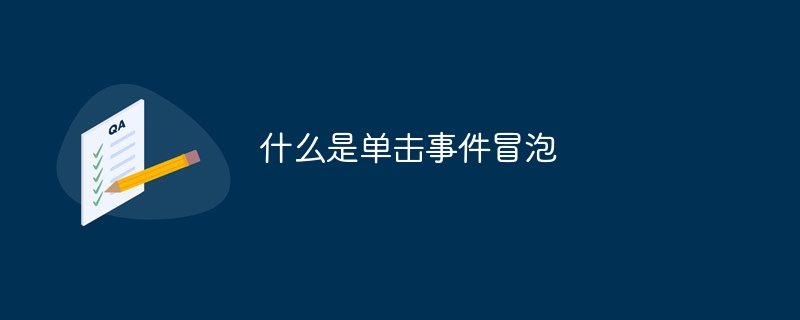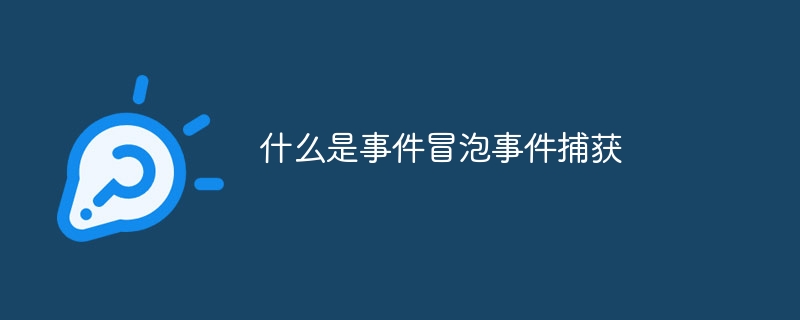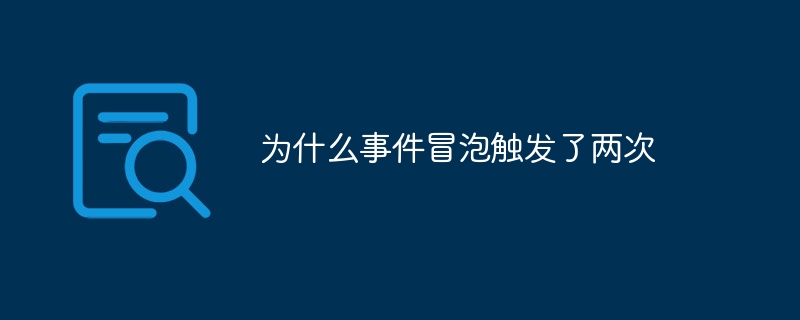 Web Front-end
Web Front-end JS Tutorial
JS Tutorial Practical Tips: Event Bubbling to Improve Web Page Intelligence and Efficiency
Practical Tips: Event Bubbling to Improve Web Page Intelligence and Efficiency
Event bubbling skills: Make your web page smarter and more efficient, specific code examples are needed
Event bubbling is an important concept in JavaScript, it can Let us process multiple elements in web pages more conveniently and efficiently. In this article, we will introduce what event bubbling is, why to use event bubbling, and how to implement event bubbling in code.
- What is event bubbling?
When there are multiple elements nested together in a page, and each element is bound to the same event handling function, when the event is triggered, the event will be triggered from the innermost element Start and then work your way up to the outermost element. This method of event delivery is called event bubbling. In short, event bubbling is the process of propagating events from the inside out.
- Why use event bubbling?
Using event bubbling has the following benefits:
2.1 More efficient
When we have a large number of elements on the page that need to be bound to the same event processing When using functions, using event bubbling can reduce the amount of duplicate code and improve code reusability and maintainability.
2.2 Smarter
Event bubbling allows us to uniformly manage the events of child elements on the parent element. By monitoring the parent element, we can selectively process them according to actual needs. A specific child element.
2.3 Easier
Using event bubbling can avoid the trouble of rebinding event handlers when adding or removing elements dynamically. Because event bubbling is delivered based on the element's hierarchical structure, no matter whether the element exists when the page is loaded or is dynamically generated later, we only need to bind the event handler to its parent element.
- How to implement event bubbling?
In JavaScript, we can bind event processing functions to elements through the addEventListener method, and obtain the target element of the event through the target attribute in the event object. Then, we can obtain the parent element through the parentNode attribute of the target element to achieve event bubbling.
The following is a specific code example that demonstrates how to use event bubbling to change the background color of a child element when its parent element is clicked:
<!DOCTYPE html>
<html>
<head>
<style>
.parent {
width: 200px;
height: 200px;
background-color: #f3f3f3;
}
.child {
width: 100px;
height: 100px;
background-color: #ccc;
}
</style>
</head>
<body>
<div class="parent">
<div class="child"></div>
<div class="child"></div>
</div>
<script>
const parent = document.querySelector('.parent');
parent.addEventListener('click', function(event) {
if (event.target.classList.contains('child')) {
event.target.parentNode.style.backgroundColor = 'red';
}
});
</script>
</body>
</html>In the above code, we first The DOM objects of the parent element and child element are obtained through the querySelector method, and then the click event handler is bound to the parent element using the addEventListener method. In the processing function, use the target attribute of the event object to determine whether the click is a child element. If so, obtain its parent element through the parentNode attribute and change its background color to red.
Through this example, we can see that we only need to bind the event handler function to the parent element to change the background color of the parent element when the child element is clicked, which greatly simplifies the writing and maintenance of code. .
By learning and using event bubbling techniques, we can make web pages more intelligent and efficient. Not only can it reduce code duplication and improve code reusability and maintainability, it can also make it easier to manage dynamically generated elements. I hope this article will help you learn and master event bubbling!
The above is the detailed content of Practical Tips: Event Bubbling to Improve Web Page Intelligence and Efficiency. For more information, please follow other related articles on the PHP Chinese website!
 极致Go语言学习:高效方法与进阶建议探讨Mar 05, 2024 am 09:18 AM
极致Go语言学习:高效方法与进阶建议探讨Mar 05, 2024 am 09:18 AM极致Go语言学习:高效方法与进阶建议探讨在当今信息技术发展迅猛的时代,全栈开发已经成为一种趋势,而Go语言作为一种高效、简洁、并发性能强大的编程语言,备受开发者们的青睐。然而,要想真正掌握Go语言,不仅要熟悉其基础语法和常用库函数,还需要深入了解其设计原理和高级特性。本文将讨论如何通过高效方法和进阶建议来提高Go语言的学习效率,并通过具体代码示例来加深理解。
 什么是单击事件冒泡Nov 01, 2023 pm 05:26 PM
什么是单击事件冒泡Nov 01, 2023 pm 05:26 PM单击事件冒泡是指在网页开发中,当某个元素被单击时,该单击事件不仅会在被点击的元素上触发,还会逐层向上触发,直到到达根元素为止。单击事件冒泡机制可以简化事件的绑定数量,实现事件委托,处理动态元素,切换样式等,提高代码的可维护性和性能。在使用单击事件冒泡时,需要注意阻止事件冒泡、事件穿透以及事件绑定的顺序等问题,以确保单击事件的正常触发和处理。
 如何利用C++进行高效的图像处理和图像分析?Aug 26, 2023 pm 01:01 PM
如何利用C++进行高效的图像处理和图像分析?Aug 26, 2023 pm 01:01 PM如何利用C++进行高效的图像处理和图像分析?图像处理和分析是计算机视觉领域中非常重要的任务,它涉及到图像的获取、处理、分析和理解。而C++作为一种高性能的编程语言,能够提供丰富的图像处理和分析库,使得我们能够快速、高效地进行图像处理和分析工作。本文将介绍如何利用C++进行高效的图像处理和图像分析,并给出相应的代码示例。图像的读取和显示在图像处理和分析中,第一
 编写高效回调函数的Java技巧与方法Jan 30, 2024 am 08:16 AM
编写高效回调函数的Java技巧与方法Jan 30, 2024 am 08:16 AM如何在Java中编写高效的回调函数回调函数是一种实现异步编程的常见方法,它提供了一种机制,使得一个函数能够在另一个函数执行完毕后被调用。在Java中,回调函数常用于事件驱动的系统或者并发编程中。本文将通过具体的代码示例,介绍如何在Java中编写高效的回调函数。定义回调接口回调函数通常由回调接口来定义。该接口中定义了回调方法,用于在合适的时机被调用。这样,任何
 如何在C语言中优化乘方函数Feb 18, 2024 pm 09:00 PM
如何在C语言中优化乘方函数Feb 18, 2024 pm 09:00 PMC语言中如何编写高效的乘方函数乘方运算是计算机程序中常用的一种数学运算。在C语言中,我们可以使用循环、递归、位运算等多种方法来实现乘方运算。然而,对于大数乘方的情况,效率往往成为一个重要的考虑因素。本文将介绍一种高效的乘方函数的实现方法,并给出具体的代码示例。在讨论高效的乘方函数之前,让我们先回顾一下乘方运算的定义。乘方运算的数学定义是将一个数(称为底数)自
 什么是事件冒泡事件捕获Nov 21, 2023 pm 02:10 PM
什么是事件冒泡事件捕获Nov 21, 2023 pm 02:10 PM事件冒泡和事件捕获是指在HTML DOM中处理事件时,事件传播的两种不同方式。详细介绍:1、事件冒泡是指当一个元素触发了某个事件,该事件将从最内层的元素开始传播到最外层的元素。也就是说,事件首先在触发元素上触发,然后逐级向上冒泡,直到达到根元素;2、事件捕获则是相反的过程,事件从根元素开始,逐级向下捕获,直到达到触发事件的元素。
 为什么事件冒泡触发了两次Nov 02, 2023 pm 05:49 PM
为什么事件冒泡触发了两次Nov 02, 2023 pm 05:49 PM事件冒泡触发了两次可能是因为事件处理函数的绑定方式、事件委托、事件对象的方法、事件的嵌套关系等原因。详细介绍:1、事件处理函数的绑定方式,在绑定事件处理函数时,可以使用“addEventListener”方法来绑定事件,如果在同一个元素上多次绑定了相同类型的事件处理函数,那么在事件冒泡阶段,这些事件处理函数会被依次触发,导致事件触发了多次;2、事件委托,是一种前端开发技巧等等。
 PHP 7.3最新函数介绍:让你的编程更加高效Jun 27, 2023 am 11:25 AM
PHP 7.3最新函数介绍:让你的编程更加高效Jun 27, 2023 am 11:25 AM作为一种广泛运用的编程语言,PHP在不断进化着,不断添置新功能。2019年初,PHP7.3版本隆重上线,其中包括许多引人注目的新功能和特性。在本文中,我们将为您介绍PHP7.3的一些最新函数,希望这些新功能能够让您的编程更加高效。is_countable函数新函数is_countable可以判断一个变量是否具有计数功能。如果变量可以被计数,则返回true


Hot AI Tools

Undresser.AI Undress
AI-powered app for creating realistic nude photos

AI Clothes Remover
Online AI tool for removing clothes from photos.

Undress AI Tool
Undress images for free

Clothoff.io
AI clothes remover

AI Hentai Generator
Generate AI Hentai for free.

Hot Article

Hot Tools

Safe Exam Browser
Safe Exam Browser is a secure browser environment for taking online exams securely. This software turns any computer into a secure workstation. It controls access to any utility and prevents students from using unauthorized resources.

PhpStorm Mac version
The latest (2018.2.1) professional PHP integrated development tool

SublimeText3 Chinese version
Chinese version, very easy to use

MinGW - Minimalist GNU for Windows
This project is in the process of being migrated to osdn.net/projects/mingw, you can continue to follow us there. MinGW: A native Windows port of the GNU Compiler Collection (GCC), freely distributable import libraries and header files for building native Windows applications; includes extensions to the MSVC runtime to support C99 functionality. All MinGW software can run on 64-bit Windows platforms.

Dreamweaver CS6
Visual web development tools





